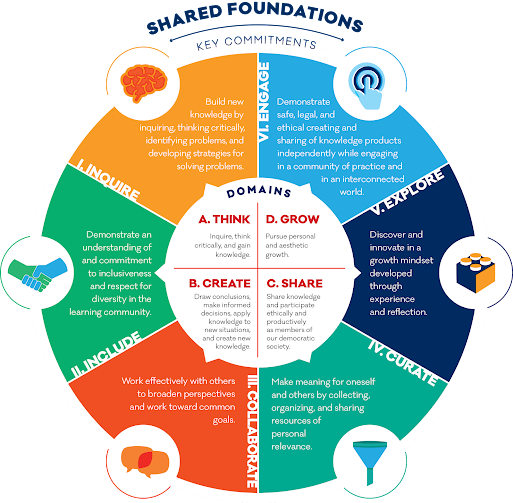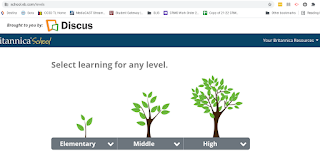AASL and ISTE Standards: Common Denominators, Core Differences
AASL and ISTE Standards: Common Denominators, Core Differences
According to the AASL, their National School Library Standards are designed to "help school librarians establish effective school libraries, and provide goals to advance programs and prepare students (K-12) for college, careers, and life" (AASL, n.d., Research Objectives). Their most recent Standards update aims to empower school librarians with a common framework to apply to and inform their work. The revised Standards still identify all the same common beliefs inherent to the profession, and both these beliefs and the Standards themselves revolve around the 3 components of the school library: the library itself, the community of learners served by the library, and the librarians whose job it is to connect learners with information resources in an ever-evolving learning environment. Standards are integrated for all 3, and they are composed of 6 shared foundations with a framework for each of the 6. 4 domains (think, create, share, grow) used within each framework are applied to mirror the learning process, with corresponding competencies (or for the library itself, alignments) identified that learners and librarians may refer to depending on their unique needs, abilities, or goals. The revised Standards represent their proposed tool for developing and honing that power to maximize library effectiveness and learner outcomes.
The ISTE identifies their Standards as "a framework for rethinking education and empowering learners," (ISTE, n.d., Our mission) and describes their vision for educators empowered "to harness technology to accelerate innovation in teaching and learning, and inspire learners to reach their greatest potential" (ISTE, n.d., Our vision). The ISTE emphasizes the role and importance of technology in achieving these goals, so their Standards naturally reflect a tech-driven approach to teaching, learning, and problem solving. They identify 14 essential conditions prerequisite to the effective use of technology in education, and there are distinct sets of standards for students, educators, administrators, and instructional coaches. While none specifically mention the librarian by name, it is no secret that the school library is often the technology hub of the school, and that librarians play an integral role in the development and execution of student education (Cromartie & Burns, 2019). There is a wealth of useful guidance and information in the ISTE standards that school librarians might use to inform instructional design and curate effective information hubs.
I won't lie: reading up on these standards felt a bit like when someone tries to explain the rules of a new board game to you. There are terms that already feel unfamiliar, and understanding some rules depends upon your familiarity with other underlying concepts or rules, so it all feels a bit daunting. As with games, the rules start to make sense as play unfolds and contextualizes some of those new words, and further research and experience in information science does the same for Standards like those put out by the AASL and ISTE. Both are tools, designed by industry experts and backed by available data, and distributed with the common goal of empowering school library professionals to make resources work for the populations they serve. Neither is fully comprehensive, but both offer a skeleton, a foundation on which a diverse array of educators, learners, and environments can build and evolve. There is also substantial overlap between the standards, as seen in the AASL and ISTE Standards for Students and Educators Crosswalk. Both sets of standards recognize similar roles, responsibilities, and opportunities for students, instructors, and instruction, even though the terms and framework each uses to do so is distinct. Growing up, when I went to my dad for help with homework, a problem, or advice, he liked to stress the importance of keeping the main thing the main thing. (Preliminary searching suggests this language may have been borrowed from Stephen Covey?) I think that both sets of Standards can be used, in conjunction with other guidelines, strategic plans, and even one another, to help school librarians to keep the main thing- serving the information needs and learning goals of the school community- the main thing.
References:
American Association of School Librarians [AASL]. (n.d.). Your voice, your standards. https://standards.aasl.org/development/
Cromartie, K. & Burns, E. (2019). Navigating the library slopes: Dispositional shifts in the national school library standards. Knowledge Quest, 47(5), 79-83.
International Society for Technology in Education [ISTE]. (n.d.). About ISTE. https://iste.org/about/about-iste



Hello Emily,
ReplyDeleteI liked your rundown of the AASL and ISTE Standards at the beginning of your post. I feel like your first two paragraphs effectively convey the goals of each set of standards. Comparing them to learning the rules of a new board game is a great comparison. I definitely learn more by playing a board game, than by reading about it. Reading through the standards, I got a similar sense that I would learn about them better through practicing them. I think that it is unavoidable that the two sets of standards would overlap, since they both incorporate aspects that are foundational to learning, like communication and exploration. My biggest takeaway from the Cromartie and Burns article, was the importance of communication, as I think that good communication skills are important for creating connections, being able to contribute effectively, and in articulating an effective defense when necessary. I really enjoyed your post.
-Jason Tucker
Emily,
ReplyDeleteI agree with you that the ISTE standards are beneficial for librarians who are looking for guidance in creating a more technologically based environment for students. It is amazing how much libraries have changed in the past ten years. I remember going into the library in elementary school and it being quiet with the focus on print materials. Whereas today, it is hub for students to collaborate, study, read, use their devices/computers, play video games, and create things.
I was a little overwhelmed with the standards initially, but watching the videos, looking at the posters and visuals, and reading the breakdown of each component helped me develop a better understanding. Obviously, these standards will be a critical part of our success in the library, so I am glad we got to learn about them in the first real week of class. I am sure as we continue throughout the semester, we will develop an even better understanding of the standards. I personally found the AASL standards more digestible and easier to implement when collaborating with others, but I understand the importance of using both in the library.
I really enjoyed your post!
-Sydney